Over centuries, the city of Bergen has been largely defined by its relation to the sea. Situated on the Norwe- gian coast, halfway between the fishing grounds of Northern Norway and continental Europe, the city has developed as an international trading hub and is today one of the most important cities for the oil industries and maritime research. ”The Ocean” at Bergen Kunsthall uses these diverse relationships to the sea as a starting point for a large-scale exhibition with works by artists and designers, research projects, and an extensive events programme. With some of the artistic projects taking place in public space, the exhibition makes use of the city, not only as a topic, but also as an arena in which art can initiate public discussions.

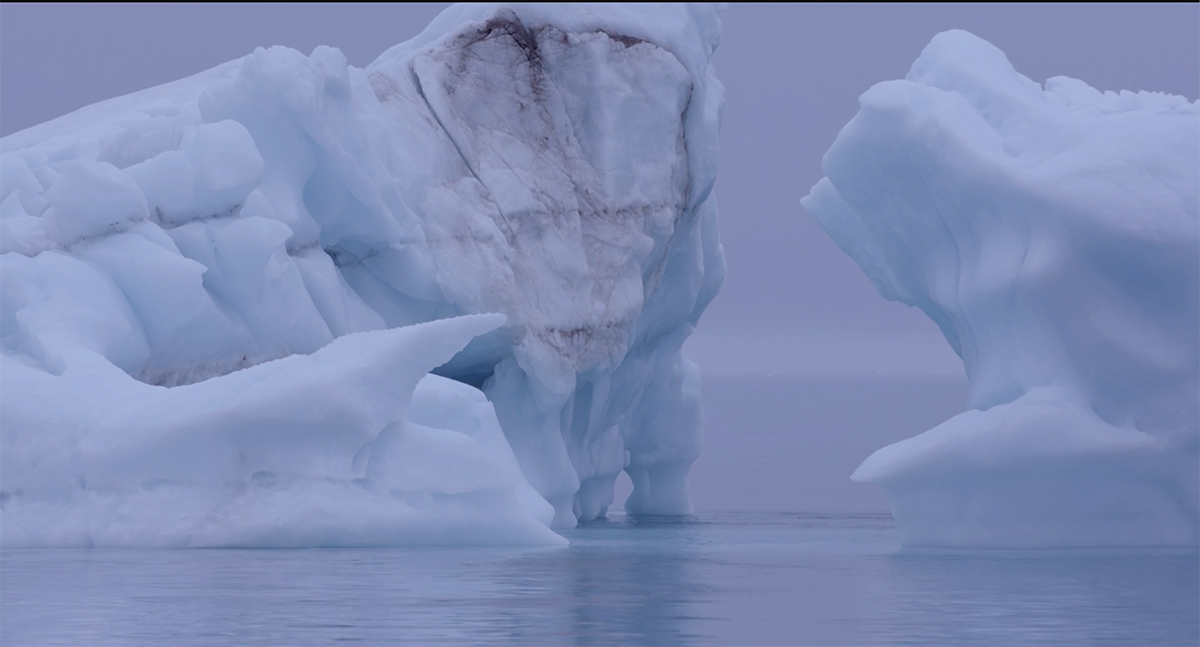
Still from Susan Schuppli, Arctic Archipelago, digital HD video, 2021
The future of the oceans has become one of the most pressing issues today due to intensification of human activities. Oceans are crucial providers of necessary and valuable resources and form a giant interconnected ecosystem, more than 70 percent of the surface of the earth are covered by water. It makes up 60 percent of the adult human body. Many artists and designers are working on related questions of ecology, climate change and global geographies. The exhibition looks at oceans from a local perspective, starting from the city, its history and future – in which the ocean as a resource and infrastructure is deeply ingrained. In Bergen, the sea is present on an everyday level, as a viewpoint in the city, economically, and culturally. Through its historic attractions such as the harbour and the world heritage-classified Bryggen area, the city is a prominent destination for cruise ships, which both exploits and solidifies the notion of the ocean in the popular imagination of Bergen. A series of museums are dedicated to maritime themes, from fishing, shipping, the history of the Hanseatic League, to sub-oceanic wildlife and coastal culture. Using specific fragments and locations, the exhibition investigates larger topics, such as the extraction of natural resources, the global circulation of goods, colonial histories and ocean life, as well as their impact on the everyday reality of the city. Artists and designers present projects that map the field of conflicts connecting to the topic of the sea: as a border and a medium of relations, as a resource and a hazard, as a concrete reality and a field of imagination.
While the exhibition has a thematic focus, it is also informed by questions of artistic methodology and an epistemological inquiry. Many of the works in the exhibition can be seen in a legacy of institutional critique, on the one hand, and a critical investment in questions of mediation on the other. Many of the works use images, sounds and other forms of representation with a strong awareness of the technological and cultural implications that these specific forms of media bring in. These works do not just question their own thematic contents, but also the ways in which information are gathered and represented, produced and consumed. Many of the works leave no possibility for us, as producers and consumers of images, to take a distanced approach. Rather, we’re already entangled, we’re embedded in the material world.
The exhibition is developed through 4 areas.

Jorge Satorre, Proposal for The Ocean 2021, drawing
The first space one enters is Gallery 2, in the middle of the exhibition. This room serves as an information hub to the exhibition. It guides visitors to the exhibition projects that are shown in other locations than the Kunsthall, presents additional material, and opens up towards the city in which this project takes place.
A central element of the space is a newspaper, Vestland North Sea Blueprints, and an accompanying series of posters that serve as a data backbone for the exhibition, mapping information about Bergen’s oceanic context and presenting a starting point for further exploration. How have human spaces and histories been entangled with the sea in the Bergen region and how do we assess the current situation? The newspaper is the result of a research project at the Bergen School of Architecture (BAS) in which Bergen Kunsthall collaborated during the preparation of the exhibition. Throughout the fall of 2020, master students at BAS investigated the long and oscillating legacy of Vestland county’s relations to the ocean. The research is organised around five major maritime industries that have been vital to the local economy: fishing, oil and gas, shipping, tourism, and renewable energy. Like an atlas, the publication gathers an extensive amount of information in maps, timelines, statistics, and diagrams to trace both local and global trajectories of these industries and how they have moulded space, culture, regimes of control, and produced specific narratives. The project aims to make a critical appraisal of Bergen’s relation to the sea, to reveal fault lines and to identify emerging spaces of renegotiation. Each section of the newspaper tells a story in an individual way, steered by the collection of most relevant findings.
The drawing by Jorge Satorre depicts the design of a public artwork which was planned for the exhibition but for various reasons could not be realised. Satorre proposed a large-scale concrete mural, six meters wide and 2,70 meters high, placed either close to the current or the future location of Bergen’s port. The mural shows an enlarged abstraction of one of the five bank notes currently in circulation that commemorate the importance of the sea in Norwegian culture. The 1,000 NOK bank note shows a large wave as its central motive. For the proposal, Satorre imagined the scene carved out of the soil at the location of the work, using the carving as a mould to cast the concrete. Today, bank notes are gradually becoming obsolete as a method for exchange and payment. Our current versions, adorned with sea-motifs, may well become the last physical currency in the country. Like a remnant of today, unearthed in an unknown future, the mural might appear like a comical flintstone currency. Will the sea still exist in this imagined future.

Wolfgang Tillmans, The State We're In, A, 2015. Courtesy Galerie Buchholz, Berlin/Cologne/New York
Two photographs by Wolfgang Tillmans represent the ocean in the most direct way, as images of water, evoking a sense of longing or perhaps memories of bygone holidays. The titles of the works open the images to broader interpretations and touch on the rich symbolic and political meaning of the sea. ”The State We’re In”, the smaller framed work, could refer both to an inner state (reading the sea as a representation of emotions), but also the actual state (the land that is bordered by the sea), where the sea often serves as a seemingly natural frontier that creates demarcation and exclusion.
The two ship models are borrowed from the collection of Bergens Sjøfartsmuseum (Bergen Maritime Museum), a museum that documents, manages and researches Norwegian maritime history and especially merchant shipping in Bergen. A large part of the museum’s model collection consists of ship models that were made to accompany existing commercial ships, for display in the owner’s offices for example. The museum collection is based in parts on gifts from the Bergen Skipper Association and the Bergen Shipowners’ Association. One of the models in this exhibition represents a ship built at Bergens Mekaniske Verksted in 1910, but later sold to Brazil where it was used as a river boat. The other model shows a machine ship built in Japan in 1973 for a Bergen shipping company. International business relations are not only part of shipping, but also ship building.

Photo: Giulia Mangione
The largest exhibition space, Gallery 1, contains works by artists that are dealing with aspects of the ocean as a geopolitical infrastructure and habitat. On the left side, arranged around a temporary wall, is a display with artworks and documents that map out some of these aspects. Vitrines with photographs, books and other materials connect with historical or contemporary facts, specifically related to Bergen. The display includes also historical art works, such as competition entries from Axel Revold and Marcus Grønvold for the competition for the murals for the old Stock Exchange in Bergen, and an iconic photograph by the first professional photographer in Bergen, Marcus Selmer.
The Sea Horse (1934) is an early film by Jean Painlevé (1902–1989), who as a scientist and filmmaker was one of the first to create images underwater. His work was celebrated by the Surrealist artists who were fascinated by the magic of the sub-aquatic reality and inventiveness of nature in Painlevé’s films, often highlighted through editing (such as slow motion, accelerated speed or blur) and music. An untitled work by Takako Yamaguchi from 1998 can be seen with a similar interest in the beauty and mystery of the underworld of the sea. The artist was born in Japan but identifies as a Californian painter and was associated with Pattern and Decoration (a movement celebrating decorativeness) at the end of the 1970s and early 1980s. The work explores the organic forms of underwater plants, animals and water flows, but juxtaposes and frames these with geometrical patterns, mathematical wave forms, sometimes creating optical effects which are enhanced by the use of applied leaf gold. The work creates a dialectic between formal and informal, organic and constructed that seems to question projections such as ”nature” versus ”culture” and associated dichotomies, such a strict separation between what is considered human and other species, wildlife or plants.

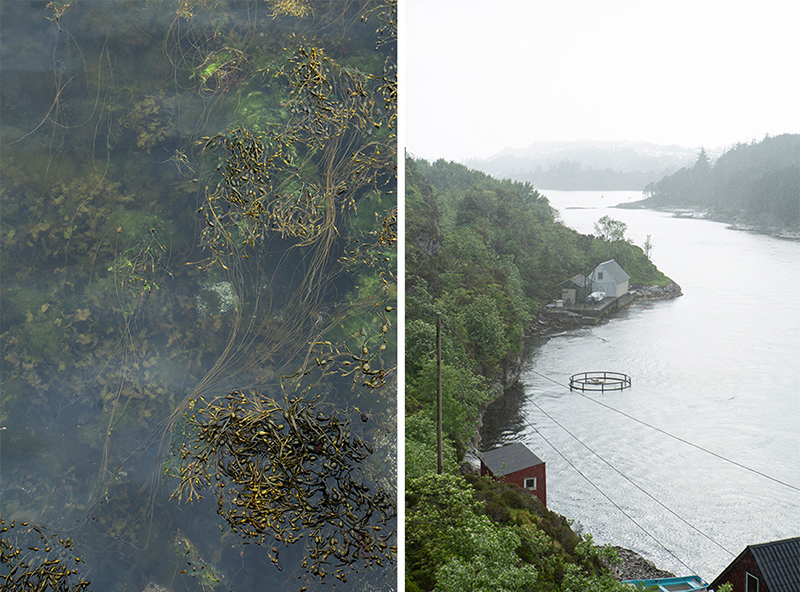
Photo: Giulia Mangione
The work of Alma Heikkilä, presented as a site-specific mural, also questions and challenges the often seemingly clear distinction between the sphere of human and other life. Her work depicts things that cannot be experienced through the human body and its senses, such as microbial life forms or ecosystems within plants or water. Heikkilä’s work for ”The Ocean” deals specifically with small-scale organisms often summarized as algae (even though there is no definition of the term that is generally accepted) that live in a remarkable variability in seawater. They interact in various and frequent ways with our bodies – we breathe the oxygen they produce, but also toxins. We might breathe the historic air that the first cyanobacteria made, but also maybe the actual cyanobacteria. We’re all made of water. Where does our body end and bodies of other species start?
Allan Sekula’s photo work Fish Story (1989–1995) is a milestone in the exploration of the ocean as a space of globalisation. The series is part of Sekula’s longstanding occupation with the role of photography in class struggle. The work was realized as a book and an exhibition, with seven chapters in total, incorporating 105 colour photographs, 26 black-and-white text panels and two slide projections. Sekula spent seven years photographing harbours and major port cities around the world. Along these journeys, he charted the migration of people and circuits of capital, chronicling – with pen and camera – the experiences of diverse workforces. A central theme in Fish Story is the connection between containerized cargo movement and the growing internationalization of the world’s industrial economy, including its effects on the actual social space of ports. The first chapter, on view here, documents the central role of the sea in the modern global economy, bringing together images from the world’s port cities. The photographs constitute a unique record of unemployment and dilapidation in the old industrial powers, the capitalist pursuit of cheap labour around the globe, and the strenuous work of seafaring.
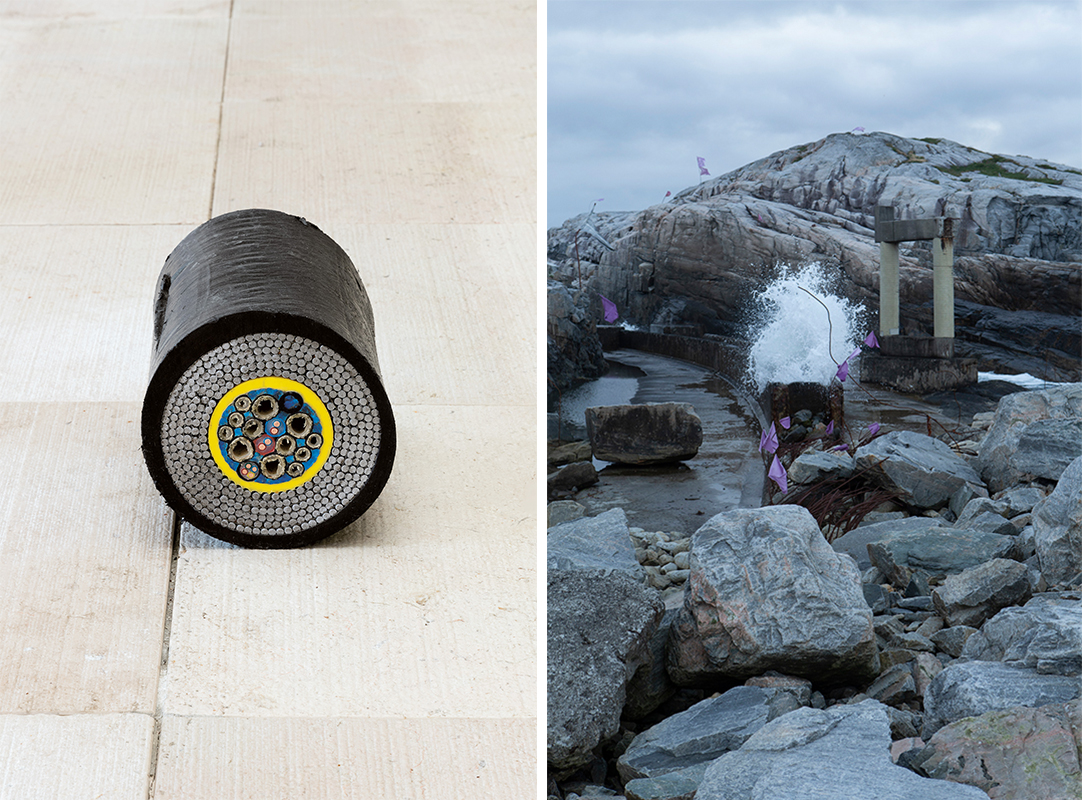
Nina Canell, Installation view: 57th Venice Biennale, 2017. Photo: Andrea Rossetti / Photo: Giulia Mangione
A group of works investigate the ocean as an infrastructure in colonisation, as it has been described by the British historian Paul Gilroy through his notion of the ”Black Atlantic” (1993). Two audio works play sound into the space at alternating times. As a double projection high up on the wall, we see Deep Down Tidal by Tabita Rezaire. The work investigates the ocean as a location and medium of colonialist and neo-colonialist power structures, specifically focusing on digital technologies as a strategy pursued by post-industrial countries to enforce their power over the rest of the world. The deep-sea transports digital data through submarine fibre optic cables that re-trace the older colonial routes of slave trade. Over 95 percent of all international communications are routed through submarine cables, which makes for an almost invisible global infrastructure upon which international trade depends. There are more than a million kilometres of cables linking every continent except Antarctica like threads in a web. ”Our water is traumatized” reads the script, scrolling in bold letters over the screen. At the same time, the work suggests that water, an element endowed with therapeutic and generative properties, can also become a locus of healing: dancing, singing, and praying on and for the ocean, as shown at the end of the film.
Ayesha Hameed’s sound installation I sing of the sea, I am mermaid of the trees is presented in a space created from cyanotype textile panels depicting gutta percha trees. The work follows the laying down of the first undersea telegraphic cable between India and Britain in the second half of the nineteenth century. The cables were strategically demanded after a six-week delay in getting the news of the outbreak of the Indian rebellion against British rule in the Revolt of 1857. Hameed’s installation moves this history underwater, taking us to battles against the forces of the seafloor, through the fragile nervousness of cable signals, and to the forests in Sarawak from where the sap of the gutta percha tree was extracted by indigenous peoples to insulate the thousands of miles of undersea cables. I sing of the sea considers how communication can act as violence, transmitted across the seafloor, consolidating imperial control. If Imperial Britain was the mother country and its colonies its offspring, then the undersea cable was a kind of strangulating umbilical cord. This is a subaquatic story of those offspring.
Undersea infrastructure is also the topic of the sculptures by Nina Canell, where short segments of undersea cables are brought into the exhibition space. The cable cuts, installed directly on the floor of the gallery space, were sourced from a company in Bergen who produces and maintains subsea cables. The cables have previously been used in the fossil fuel industry, some to control subsea pumps and others to keep pipes for oil and gas warm to prevent clogging. Nina Canell often uses found objects, presented in their raw material form, with an interest in the processes and transformation that take place within material hosts. Her works are shown for their metaphorical as well as indexical nature: the power, the circulation, the time and the space that these cables were part of and helped to create.
Susanne Kriemann’s photo work Mngrv is the result of her encounter with mangrove trees in South and Southeast Asia. Growing in the coastal intertidal zone, their rhizomatic roots are exposed to the rhythm of the tides and get entangled with fishnets, plastic waste, and oil remnants. Mngrv explores how in times of climate change and environmental pollution the borders between nature and culture, plant, and plastic, increasingly blur. The photographs that Kriemann took during field research in Sri Lanka and Indonesia were later imprinted with plastic waste she found on location, using raw oil collected from the water as pigment. Neither rope nor root, nylon nor plant, Mngrv is a material witness to the intertidal processes and shaped by the forces of capitalism, colonialism, and petroculture – of which the artist as well as anyone engaging with the work are inevitably part as well. A publication is available for sale in our bookshop, all income will be transferred to the mangrove movement Desa Wisata Pengudang of Bintan, Indonesia to support their efforts and collaborations.

Collecting water in Fukushima for Ei Arakawas Per Kirkeby & Iwaki Ocean’s Temporal Visit. Photo: Tomoo Arakawa
The Sámi interdisciplinary artist Keviselie or Hans Ragnar Mathisen makes drawings and prints, as well as working as a writer and festival organizer. Since 1975 he has also produced a series of maps, which are entirely held in Sámi language. The maps are devoid of any local or national borders and use Sámi place names, which have often been removed by the various nation states that governed Sápmi since the 17th century. Mathisen was a member of the legendary Mázejoavku: Sámi Dáiddajoavku (Sami artist group) from 1978 to 1983 in Máze (Masi). His map works follows this thread of artistic activism, advocating for Sami rights and guiding us through questions about migration, the nation state and exploitation of natural resources such as the ocean. The maps are accompanied by a series of watercolour drawings and prints which highlight the relation to water in what can be seen as a pact with nature.
Em’kal Eyongakpa presents an immersive sculptural environment which is activated in the exhibition every 30 minutes, for three minutes. The work is a new commission for the exhibition titled batu kɛnɔŋ XII-rh/ babhi-bɛrat XII-r [babhi-manyɛp/ babhi-bawɛt, (mbaŋ)]. The work’s title is written in Kɛnyaŋ, a language widely spoken in the Cross River basin in Cameroon. The installation forms part of Mbaŋ (2020-), an ongoing body of work including live sonic sketches, processions and kinetic sound sculptures through which Eyongakpa explores ideas around portals, crossings and water in relation to resistance movements from the oil and natural gas-rich region of the Gulf of Guinea and beyond. Eyongakpa works with composite multichannel soundscapes, creating polyrhythmic water and oil-based sound sculptures. The fragmented soundscapes within Mbaŋ are achieved mainly in real time, recorded from the geophony and biophony around the installation sites, or procession itinerary. Mbaŋ broadly translates as weather, flute, land (farmland), while mbi translates as path, route, (pl. babhi). bawɛt translates as oil, manyɛp translates as water. babhi-manyɛp/babhi-bawɛt would literally translate as water ways/oil ways. Babhi-bɛrat translates broadly as 3 paths, 3 routes, 3 trajectories. Ntu (pl. batu) translates as cargo, load, while kɛnɔŋ would be either iron, bicycle or prison. These subtitles consequently have multiple readings that draw from indigenous aesthetics recurrent in the Manyu region. The installation for ”The Ocean” is based on a transcription of sound recordings made with a popular Dutch transport bicycle, bakfiets, along selected routes and activated in the exhibition space by custom-made pulsating platforms, incorporating repurposed ammunition boxes and oil barrels. The itineraries included significant sites such as Patrice Lumumbastraat, Ken Saro-Wiwastraat and a Shell petrol station in South-East Amsterdam, and used texts parts from the poet Christopher Okigbo, Bate Besong’s The Obasinjom Warrior and others.
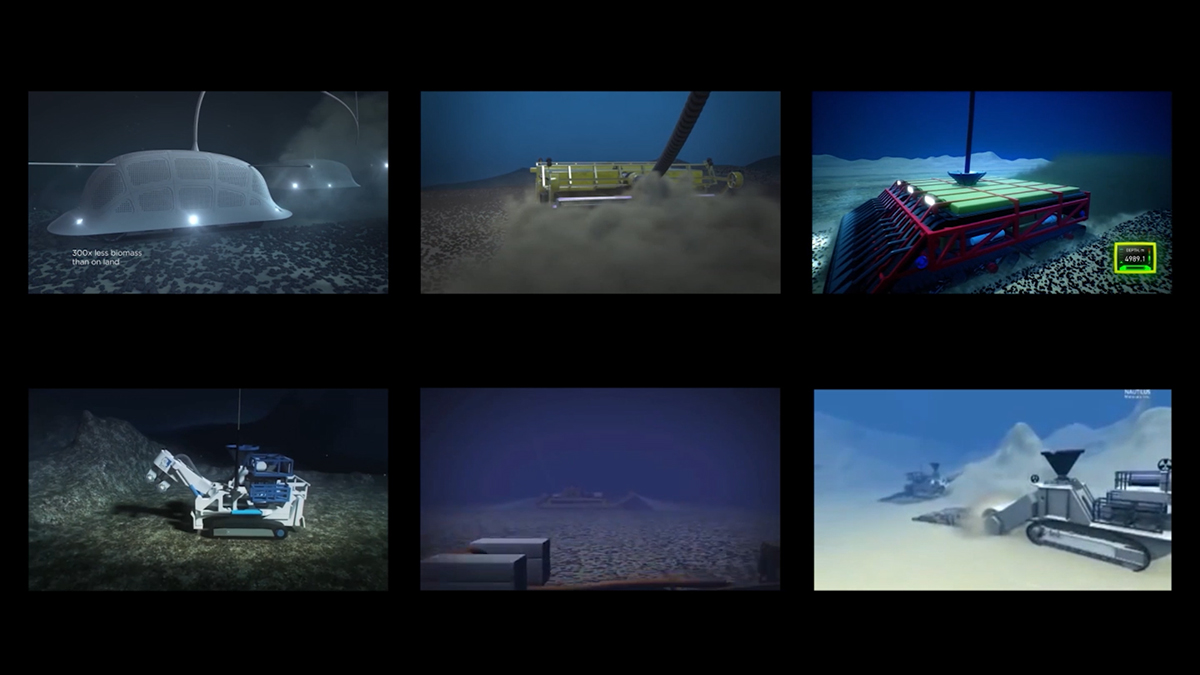
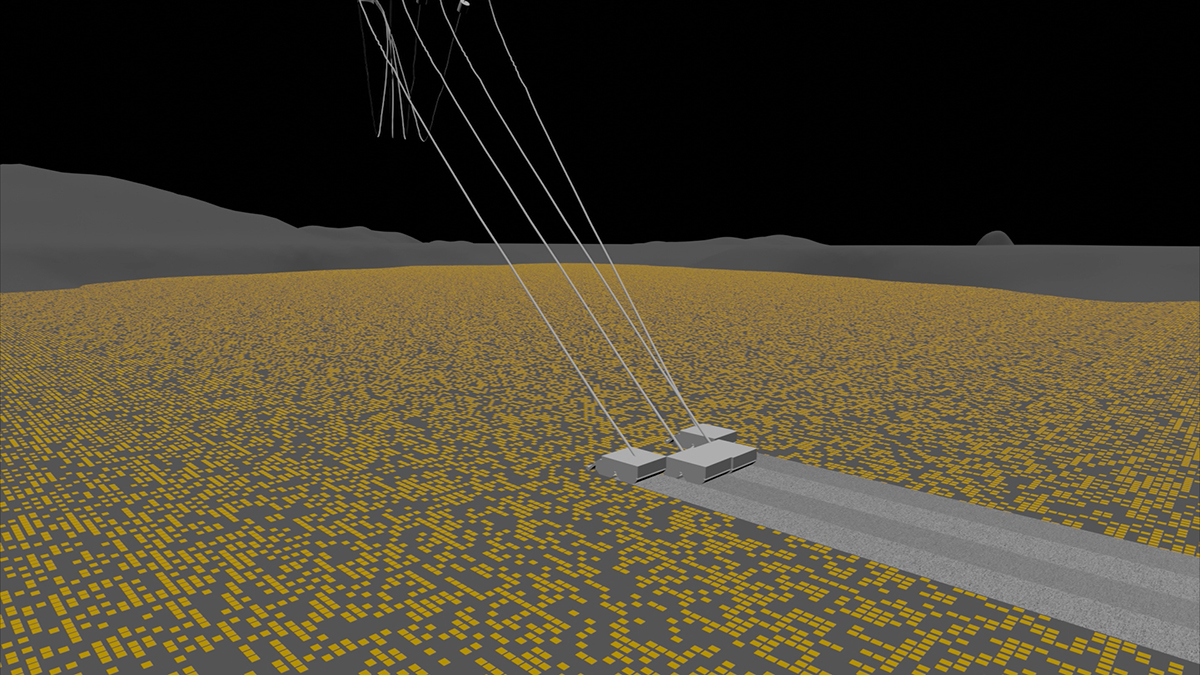
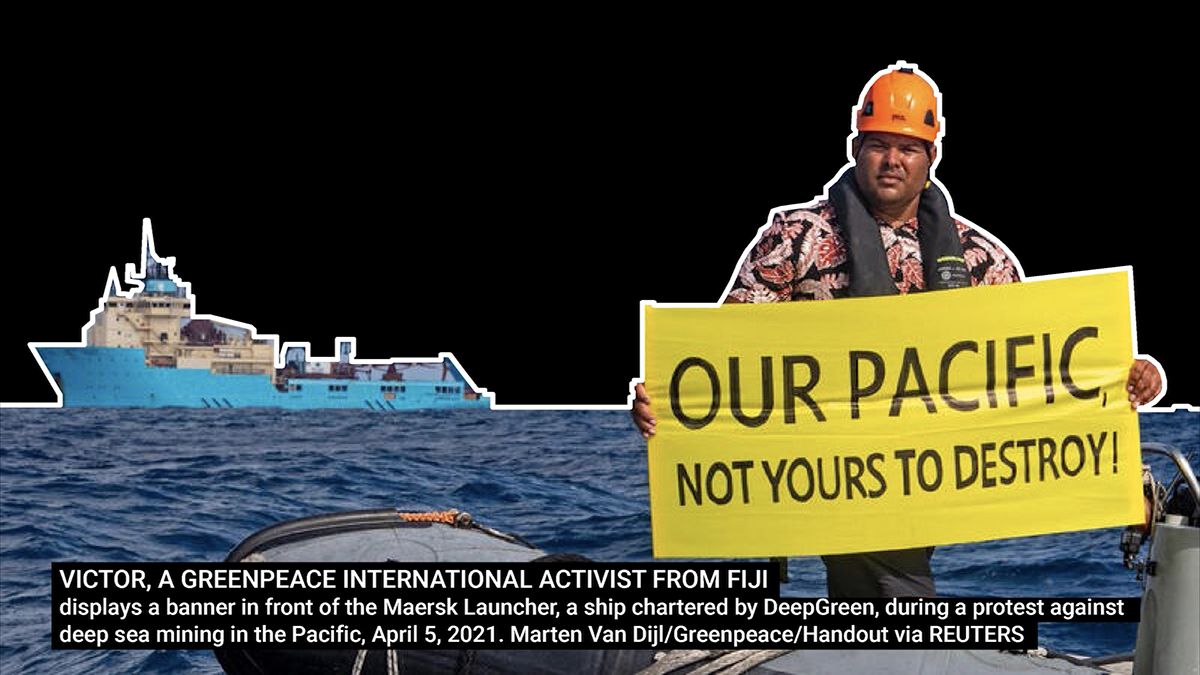
INTERPRT: Stills from INTERPRT: NO-CCZ, 2021. HD Video, 9 mins.
The works in gallery 3 present an investigation around questions of extraction and the limits and politics of ocean resources.
The installation NO-CCZ by the design and research studio INTERPRT continues their ongoing visual investigation on deep-sea mining and consists of two parts. The first is a diagram that interrogates the Norwegian government’s current public consultation process on whether to open-up its continental shelf for deep-sea mining, in the context of what might be referred to as Norway’s ”mineral-development complex”. The second part is a video from a long-term multimedia advocacy project – developed with Deep Sea Mining Campaign and Ozeanien Dialog in collaboration with scientists and Pacific civil society organizations. The video models, visualises and predicts environmental destruction from deep-sea mining in the Pacific. The investigation by INTERPRT focuses on two of the emerging sites where plans for deep-sea mining are accelerating at an alarming pace: Norway’s continental shelf (NO) in the Nordic Seas and the Clarion Clipperton Zone (CCZ) in the Pacific Ocean. Covering an area over 1 million square kilometres, and at an average depth of 5000 meters, the Clarion Clipperton Fracture Zone (CCZ) is located in the international waters of the Pacific Ocean under the jurisdiction of the International Seabed Authority (ISA). Currently the ISA has entered into a series of contracts with state parties for the exploration of polymetallic nodules, including cobalt, nickel, copper and manganese in the area. At the core of INTERPRT’s advocacy video is a 3D model that simulates full-scale mining and plumes (sediment and midwater discharge) using the OpenDrift particle trajectory modeling software. The 3D model was created using bathymetric data, AUV sampling (videos and photographs) and habitat mapping shared with us by scientists working within the CCZ contract areas and the Areas of Particular Environmental Interest (APEIs).


Kåre Grundvåg & Trond Ansten, Intertidal Shelter part I and II, LIAF 2019
In addition to their new work Intertidal III located on the ocean shore in Bergen, the artists Trond Ansten and Kåre Aleksander Grundvåg also shows two parts of a previous iteration of the project, first presented as Intertidal Shelter I during LIAF (Lofoten International Art Festival) in 2019. Similar to the new project, Intertidal Shelter I was designed as a micro-farm for seaweed but consisted of carved wood that stretched vertically from the lower to the upper point of the tidal zone, located at the harbour in Svolvær. Three of the initially six works were taken by the sea and one was stolen.
The works by Ansten and Grundvåg are presented next to a vitrine with documents and models made by the architect and futurist Wolf Hartmut Hilbertz. In 1976 Hilbertz invented a process for self-creating structures in seawater, named Cybertecture. He also developed drafts for environmental systems and systems based on mineral accretion and shared the technology’s principles often and openly, amongst others in his position as a professor at The University of Texas at Austin.
Peter Fend produces in-situ scenarios which are intended, if realised, to improve the inhabited world. In 1980, together with other US artists, he founded a company now called Ocean Earth Development Corporation, which produces art-sourced projects for non-art clients. Projects by Ocean Earth and Peter Fend are, even if seemingly utopian in scale, intended for realisation. In this ambition, Fend’s works in the exhibition are rather documents or models that point to the actually intended output. The works presented relate to two connected projects: the first is a re-zoning of the world in hydrometric zones, beyond currently existing national or administrative borders, that gives each zone sufficient access to water resources. In these projects, Fend questions current geopolitical power relationships and points to the influence of politics and global finance. This approach is presented through a set of maps of Chile. A second work, Offshore Soil Rig (1993), is a prototype for the cultivation of the algae Macocystis (Giant Kelp), which Fend proposes as an alternative energy source to oil. With access to water, this would allow communities to gain independence from the corporate oil industry.

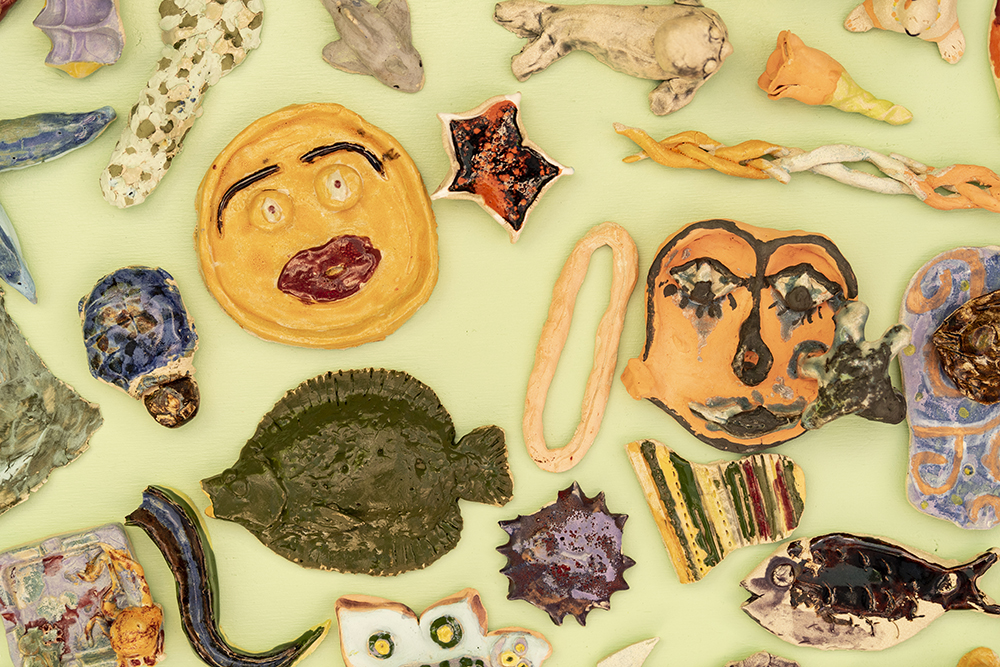
Yuri Pattison, sun (set) provisioning, 2019. Courtesy the artist and mother’s tankstation, Dublin / SolCalero: Installation view of Sol Calero, Casa Isadora, 2018–21, in Byparken. Wood, metal, ceramic. Photo: Thor Brødreskift
Ina Hagen’s new audio-visual work Fire Nation engages with the rebranding of the Norwegian state-owned energy company Statoil to Equinor in 2018, and the accompanying expansion to so-called ”broad energy”, with a future-oriented, socially and ecologically conscious image. At the same time, Equinor is the largest international company in terms of oil extraction volume in Brazil, projected to be one of the top five oil producing areas in the world by 2030. 82 percent of this production is in ”ultra-deep water” (at depths of more than 1500 meters), risking contamination of the ocean (like Deepwater Horizon), deterioration of marine life, and the prosperity of local communities and the global ecosystem. The Norwegian Oil Adventure’s second chapter is being written across the Atlantic. What does it mean to extract natural resources from “elsewhere” whilst championing climate conscious innovation at home?
Fire Nation departs from a 2018 promotional video by Equinor and couples the images with recordings from conversations about climate optics, colonial exploitation, power and powerlessness. The audio track also contains a field recording from Praça Mauá, an important port area in Rio de Janeiro since the Imperialist era. The work is inspired by the research project ”ENERGETHICS - Norwegian energy companies abroad” by the University of Bergen, Chr. Michelsen Institute, and the University of Sussex.
The photograph I’m Coming Home in Forty Days was made by Jeroen de Rijke and Willem de Rooij during a travel to Greenland (Kalaallit Nunaat) in 1997. The image shows water close to an iceberg in the bay of Ilulissat that the artists circumnavigated. Like an illusive monument, the artists never came close or touched the ice. The image oscillates between abstraction and realistic depiction of the landscape. Seen from today the work can be read both as a moment of ambivalent fascination for the melting ice and an eagerness to find images for Nordic colonial history.
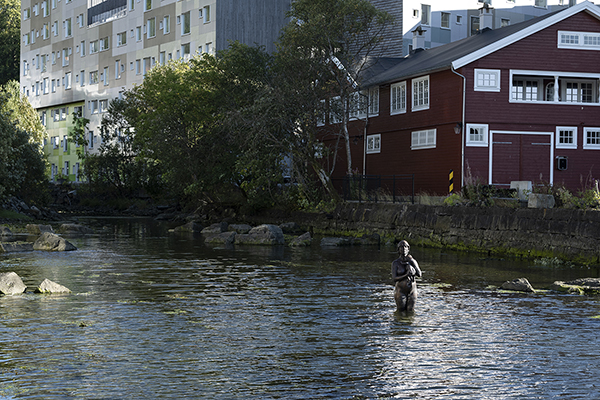
Bea: Installation view of Bea Schlingelhoff, Bronze Sculpture Dedicated to The Descent of Woman, 2021, in Møllendalselven. Bronze, concrete. Courtesy of the artist. Photo: Thor Brødreskift
OCEAN SPACE
Bergen Kunsthall
28.8. – 31.10.2021
Curated by Axel Wiedel
Artists: Trond Ansten/Kåre Aleksander Grundvåg, Ei Arakawa, Sol Calero, Nina Canell, Em’kal Eyongakpa, Peter Fend, Fragment, Ina Hagen, Ayesha Hameed, Alma Heikkilä, INTERPRT, Susanne Kriemann, Giulia Mangione, Hans Ragnar Mathisen, Yuri Pattison, Tabita Rezaire, Jeroen de Rijke/Willem de Rooij, Jorge Satorre, Bea Schlingelhoff, Susan Schuppli, Allan Sekula, Wolfgang Tillmans, Elin Már Øyen Vister, VUMA, Takako Yamaguchi, Explorations in Ocean Space II – Vestland North Sea Blueprints (Bergen Arkitekthøgskole (BAS), teachers: Nancy Couling, Vibeke Jensen, Julia Morrissey) and selected documents and materials.


